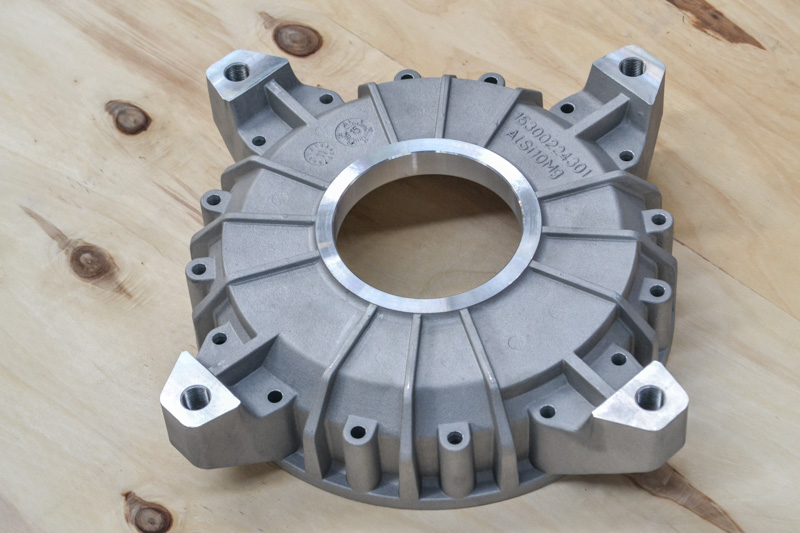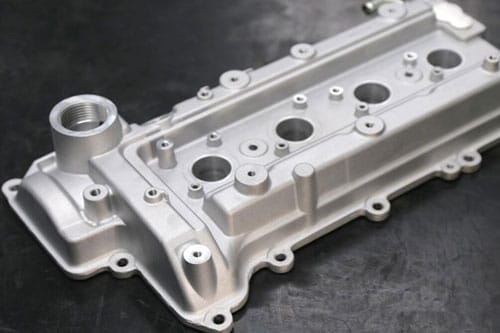Understanding the material properties of Aluminum Castings and their industrial uses
Wiki Article
Just How Aluminum Foundry Contributes to Cutting-edge Solutions in Steel Fabrication
Aluminum factories considerably influence the landscape of steel construction. They take on sophisticated spreading methods that boost accuracy and layout flexibility. This capacity permits for the production of light-weight and durable elements that accommodate varied sector requirements. Additionally, the assimilation of automation and sustainable methods establishes a criteria for performance. As these foundries develop, they question concerning the future of production and the duty of advancement fit the market.The Duty of Aluminum Foundries in Modern Production
Aluminum factories play an essential duty in contemporary production, contributing substantially to different markets, consisting of auto, aerospace, and durable goods. These facilities specialize in the melting and casting of light weight aluminum, changing basic materials into high-quality elements that meet rigid sector criteria. The light-weight yet solid properties of Aluminum make it an optimal selection for suppliers aiming to improve performance while decreasing weight, specifically in the auto field, where fuel effectiveness is paramount.Aluminum foundries make use of ingenious procedures to create complicated forms and designs that provide to specific market needs. By leveraging innovative technologies such as computer-aided layout and simulation, these shops can maximize their manufacturing processes and boost product use. This not just enhances the high quality of the end products however additionally lessens waste, contributing to more sustainable manufacturing methods. Inevitably, the contributions of Aluminum shops are critical for driving development and effectiveness across numerous markets.
Advanced Spreading Techniques Changing Metal Manufacture
Advanced casting methods are reinventing the field of metal fabrication, particularly with precision casting methods that improve accuracy and reduce waste. Cutting-edge alloy developments are additionally playing an essential role, permitting tailored buildings and boosted efficiency in numerous applications. Together, these advancements are establishing brand-new criteria in performance and high quality within Aluminum foundries.Precision Casting Methods
As the need for top notch elements in different sectors remains to climb, precision casting techniques have become a transformative pressure in metal construction. These methods, including investment spreading, shed foam casting, and die spreading, allow for complex geometries and limited resistances that standard techniques often have a hard time to attain. By utilizing advanced products and innovations, accuracy casting minimizes waste and boosts effectiveness, enabling manufacturers to generate intricate get rid of decreased lead times. In addition, these approaches provide exceptional surface coatings and mechanical homes, making them excellent for industries such as aerospace, vehicle, and medical gadgets. As makers progressively take on accuracy spreading, the capacity to fulfill certain layout needs while keeping cost-effectiveness comes to be an essential benefit in today's open market.Ingenious Alloy Advancements
Ingenious alloy growths are improving the landscape of steel manufacture, especially within the domain of precision spreading. Advances in material scientific research have brought about the production of specialized Aluminum alloys that improve stamina, resistance, and longevity to rust. These unique alloys enable foundries to produce intricate parts with enhanced mechanical buildings, accommodating varied industries such as aerospace, auto, and electronics. The consolidation of sophisticated casting methods, consisting of die casting and sand spreading, further maximizes the usage of these materials, permitting intricate geometries and decreased waste. Because of this, manufacturers are much better geared up to fulfill strict efficiency standards while reducing ecological impact. Inevitably, these innovative alloys are leading the way for a new age of performance and sustainability in metal manufacture.Resilient and light-weight: The Advantages of Aluminum Parts
Aluminum components offer considerable benefits in various applications because of their light-weight nature and resilience. This mix contributes to boosted fuel effectiveness, especially in the aerospace and vehicle sectors. Additionally, aluminum's integral rust resistance better expands the lifespan of products, making it a favored option in several steel construction procedures.Boosted Gas Performance
While traditional materials have long been the standard in numerous markets, the change towards Aluminum parts is changing the landscape of metal fabrication, specifically in connection with improved fuel performance. Aluminum's lightweight nature significantly lowers the total weight of cars and machinery, allowing for boosted performance and reduced energy consumption. This decrease in weight converts directly to reduced gas usage, making Aluminum an eye-catching choice for producers intending to satisfy strict environmental regulations. Furthermore, aluminum's toughness warranties that elements preserve their integrity over time, adding to lasting performance. As markets progressively prioritize sustainability, the adoption of Aluminum elements becomes a strategic selection, lining up functional objectives with ecological obligation while enhancing gas performance in numerous applications.Rust Resistance Advantages
One of the standout functions of Aluminum elements is their phenomenal corrosion resistance, which substantially improves the longevity and integrity of different applications. This residential or commercial property is specifically helpful in harsh settings, such as marine and commercial settings, where direct exposure to moisture and chemicals can cause substantial deterioration in other steels. Unlike steel, Aluminum normally develops a safety oxide layer that works as a barrier versus ecological components, reducing the threat of rust and corrosion. Consequently, Aluminum components require less maintenance and have a longer solution life, making them an economical selection for makers. This intrinsic resilience not only adds to the overall performance of products but likewise supports sustainability initiatives by lowering the need for frequent substitutes.Innovations in Design and Design Through Aluminum Foundries
As improvements in Aluminum Foundry innovation remain to improve the landscape of steel fabrication, innovative style and design solutions are arising to satisfy the demands of diverse industries. The adaptability of Aluminum allows for complex layouts that were formerly unattainable with typical products. Shops are leveraging computer-aided design (CAD) software program and simulation tools to optimize the design process, making it possible for engineers to published here create lightweight yet robust elements tailored to certain applications.Moreover, the ability to include advanced alloying methods permits the modification of Aluminum homes, improving toughness and toughness. This flexibility promotes creative thinking in product advancement, permitting companies to experiment with new shapes and structures that boost performance while minimizing weight. Collective initiatives between developers and foundries help with fast prototyping, causing much shorter project timelines and raised overall efficiency. These innovations not only enhance product performance but also drive sustainability by lessening material waste during the manufacture process.
Enhancing Performance With State-Of-The-Art Modern Technology
Improvements in state-of-the-art modern technology are reinventing the efficiency of Aluminum foundries, improving procedures from layout to production. Automation plays a crucial duty, with robot systems improving the rate and precision of jobs such as molding, putting, and ending up. These automated solutions minimize human mistake and reduce labor prices, while also increasing output consistency.Furthermore, the integration of sophisticated software application for computer-aided layout (CAD) and simulation enables for quick prototyping and testing, expediting the shift from concept to manufacturing. Foundries are making use of real-time information analytics to monitor operations, ensuring peak efficiency and decreasing downtime.
In addition, 3D printing innovation is being taken on for producing complex molds and elements, reducing material waste and lead times. The combination of these innovative modern technologies not only boosts performance yet likewise improves the high quality of Aluminum products, positioning foundries at the forefront of innovation in metal manufacture.
Lasting Practices in Aluminum Foundries
A growing number of Aluminum factories are adopting lasting practices to reduce their environmental impact and promote source efficiency. Aluminum Foundry. These foundries are significantly implementing recycling programs, where scrap Aluminum is accumulated and recycled, significantly lessening waste. Furthermore, energy-efficient modern technologies, such as electric heaters and progressed insulation materials, are being made use of to reduced power intake during the melting procedureWater conservation techniques are also getting grip, with several foundries reusing water in cooling systems to lower total use. In addition, the adoption of environment-friendly coatings and ingredients decreases damaging exhausts without endangering product top quality.
Future Trends in Aluminum Spreading and Metalworking
Increasingly, the future of Aluminum spreading and this article metalworking is being formed by technological developments and progressing sector requirements. Advancements in automation and robotics are enhancing procedures, improving accuracy, and decreasing labor prices. The adoption of additive production techniques, such as 3D printing, is changing standard casting techniques, permitting for intricate geometries and lowered product waste.The combination of artificial knowledge and information analytics is enabling real-time tracking and anticipating upkeep, which optimizes manufacturing performance. Sustainability continues to be a core focus, with firms spending in environmentally friendly methods, including the recycling of Aluminum scrap and the use of sustainable power resources in production.
As the demand for lightweight, long lasting materials in different sectors increases, Aluminum foundries need to adjust by developing cutting-edge alloys and improving spreading techniques. These fads collectively indicate a future where Aluminum casting and metalworking are extra reliable, lasting, and responsive to market needs.

Frequently Asked Concerns
What Kinds Of Aluminum Alloys Are Commonly Made Use Of in Foundries?
Generally used Aluminum alloys in foundries include 2xxx collection (copper), 3xxx collection (manganese), 4xxx collection (silicon), 5xxx collection (magnesium), and 6xxx series (magnesium and silicon), each offering one-of-a-kind properties suitable for numerous applications.Exactly How Does Aluminum Casting Contrast to Other Steel Fabrication Approaches?
Aluminum casting deals advantages such as lower production expenses and intricate forms contrasted to traditional fabrication techniques. It provides exceptional dimensional precision and surface area finish, making it a recommended selection for several industries over alternatives like machining or welding.What Precaution Are Applied in Aluminum Foundries?
Aluminum factories apply various safety measures, including individual protective equipment, air flow systems, normal safety training, hazard evaluations, and emergency methods to shield workers from risks related to molten metal, warm, and possible chemical exposure. Wisconsin Aluminum Foundry.How Can Firms Discover Dependable Aluminum Foundry Allies?
Business can recognize trustworthy Aluminum Foundry partners by reviewing industry online reputation, examining customer endorsements, appraising high quality you can try this out qualifications, considering production abilities, and performing website visits to ensure placement with their particular demands and standards.

What Is the Typical Lead Time for Aluminum Spreading Projects?
The normal preparation for Aluminum casting projects ranges from 2 to 8 weeks, depending on aspects such as layout complexity, production volume, and the shop's capability to fulfill details job requirements and timelines.
Aluminum shops play an essential function in modern manufacturing, adding considerably to numerous sectors, consisting of auto, aerospace, and consumer products. As developments in Aluminum Foundry innovation continue to reshape the landscape of steel construction, ingenious design and design solutions are arising to fulfill the demands of varied industries. Advancements in cutting edge modern technology are changing the efficiency of Aluminum foundries, improving processes from design to production (Aluminum Castings). A growing number of Aluminum shops are adopting lasting techniques to minimize their environmental influence and promote source performance. As the demand for light-weight, sturdy products in different markets boosts, Aluminum shops need to adapt by boosting and developing cutting-edge alloys casting methods
Report this wiki page